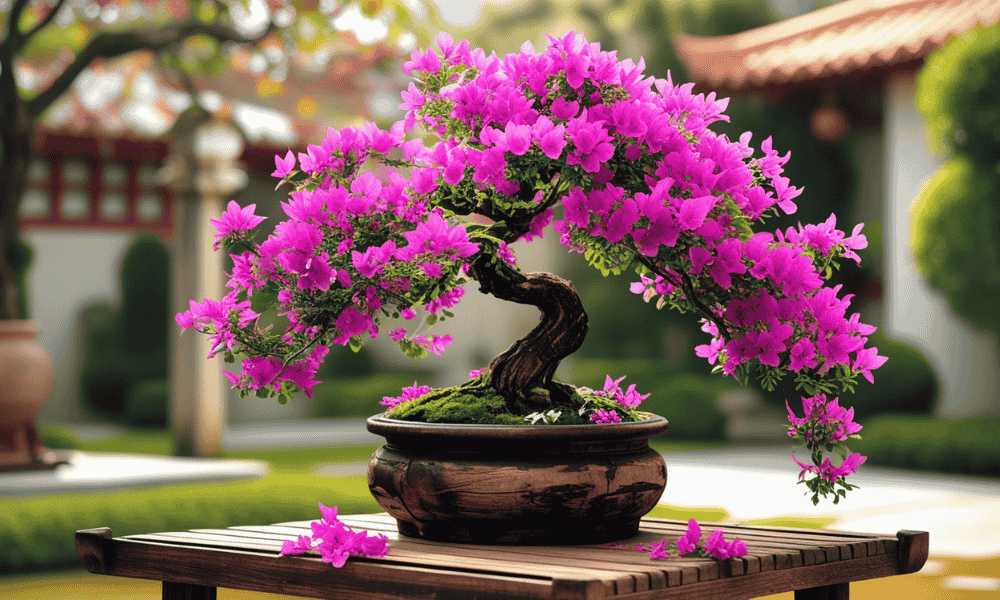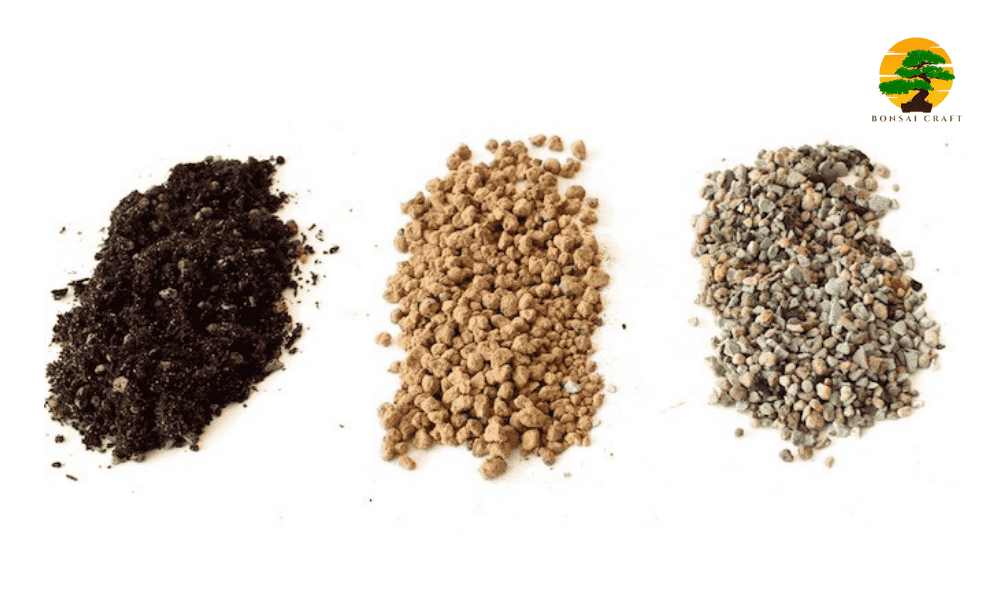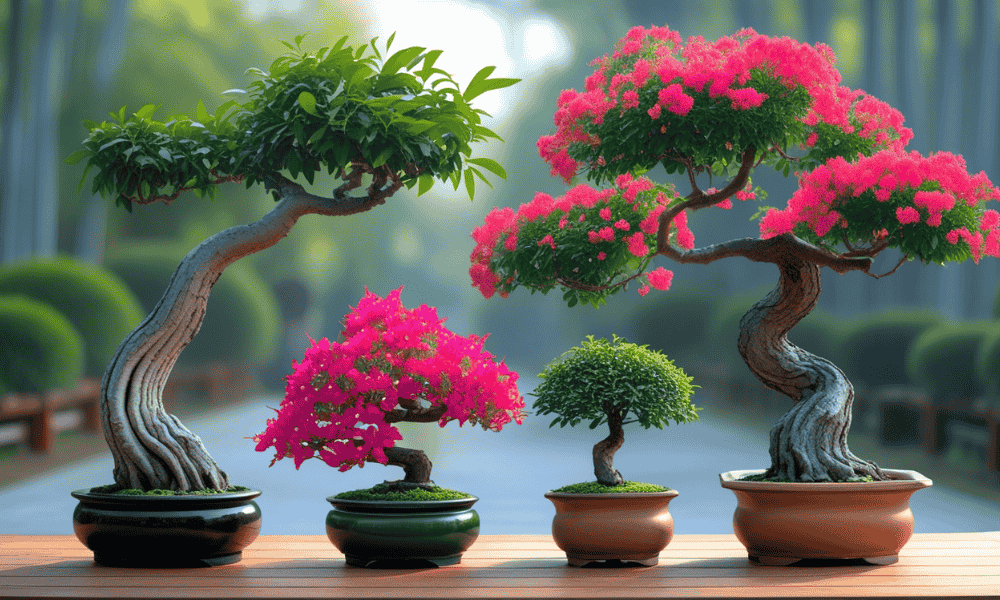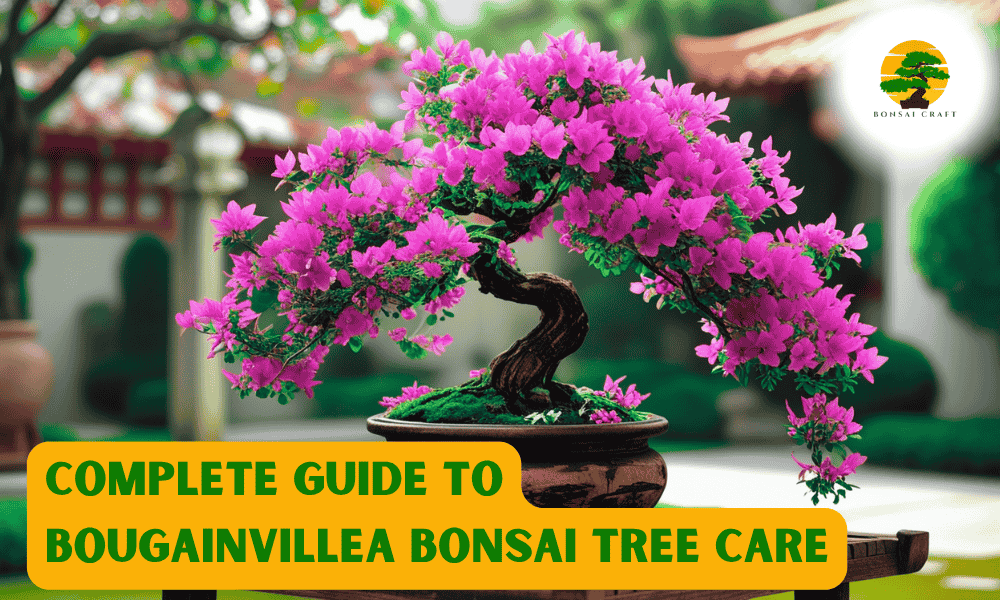
The bougainvillea bonsai tree is a stunning miniature version of the classic bougainvillea vine, renowned for its vibrant bracts and trailing elegance. It combines the tropical appeal of this sun-loving plant with the disciplined artistry of bonsai cultivation. Whether grown on a sun-drenched balcony or styled in a bonsai cascade form, the bonsai bougainvillea offers a dazzling visual display—and a fulfilling horticultural challenge.
In recent years, the popularity of bougainvillea bonsai trees has surged due to their adaptability, vivid colors, and unique bonsai styling potential. As gardeners look for plants that not only beautify their homes but also express their personality and craftsmanship, bonsai bougainvilleas stand out as ideal candidates.
This in-depth guide explores everything you need to know about growing and caring for a bougainvillea bonsai, from basic care to advanced styling techniques like cascade or pixie forms, helping both beginners and seasoned growers succeed.
🌞 What is a Bougainvillea Bonsai?
A Fusion of Tropics and Bonsai Artistry
Bowainvillea bonsai is the flowering bougainvillea shrub or vine sculpted into a miniature form. This species is particularly fond of warm and sunny climates and is native to South America, encompassing Brazil, Peru, and Argentina. Bougainvillea bonsai trees achieve aesthetic miniaturization through pruning, wiring, and potting while they mimic the growth behavior of full-sized plants.
Why Choose Bougainvillea for Bonsai?
- Vibrant Blooms: Their trademark paper-like bracts come in bold shades of magenta, fuchsia, white, orange, red, and purple.
- Drought-Tolerance: A mature bougainvillea bonsai plant can handle dry spells better than many other bonsai species.
- Artistic Flexibility: Can be styled as informal upright, slanting, semi-cascade, or full cascade bougainvillea bonsai.
- Symbolism: In many cultures, bougainvilleas represent passion, endurance, and peace, making them meaningful gifts or meditative projects.
☀️ Bougainvillea Bonsai Tree Light Requirements
Sunlight: The Key to Color and Growth
Light is the most critical factor in achieving a flourishing bonsai bougainvillea tree. Bougainvilleas require 6–8 hours of direct sunlight daily to bloom profusely and maintain vibrant foliage.
Best Placement Tips:
- Outdoors: Place on a bright patio or balcony with full sun exposure.
- Indoors: Keep near a south-facing window; use full-spectrum grow lights if natural sunlight is inadequate.
💡 Pro Tip: Rotate the pot every few days to ensure even growth and balanced light distribution.
💧 Watering: The Dry-and-Soak Technique
Watering a bougainvillea bonsai tree incorrectly is one of the most common mistakes among beginners.
The Right Way to Water:
- Let the topsoil dry out slightly between waterings.
- When watering, fully saturate the root zone until water drains out from the pot’s base.
- Avoid soggy soil or constantly moist conditions—these can lead to root rot.
Tools That Help:
- Soil moisture meter: Offers precise control.
- Unglazed bonsai pots: Aid drainage and air flow.
Insight: Users often search “how to take care of bougainvillea bonsai” after encountering yellowing leaves or overwatering. Including practical watering advice like the dry-and-soak method can answer AI-generated snippets effectively.
🌱 Best Soil for Bougainvillea Bonsai Plant
The right soil supports healthy root development, good drainage, and aeration—all critical for bougainvillea bonsai care.
Recommended Soil Composition:
- 40% Akadama (retains nutrients)
- 30% Pumice (promotes drainage)
- 30% Lava Rock or Grit (prevents compaction)
Or you can use a custom mix:
- 1 part bonsai soil
- 1 part perlite or pumice
- 1 part organic compost
🛒 Buying Tip: Look for “well-draining bonsai soil mix” or “bonsai mix for flowering trees” at local nurseries or online bonsai shops.
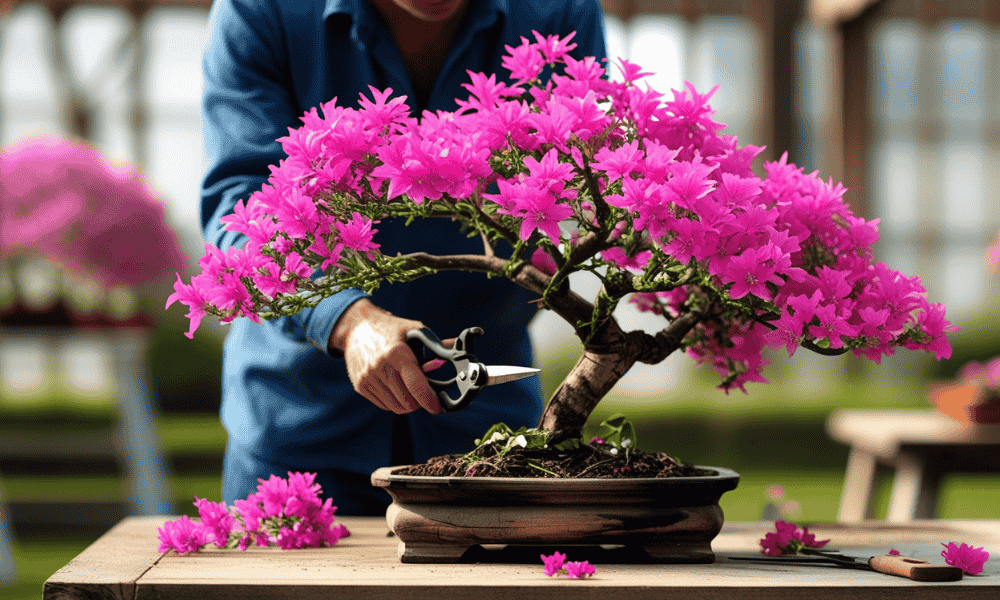
✂️ Pruning and Shaping Your Bougainvillea Bonsai
Mastering how to prune bougainvillea bonsai trees is crucial for controlling growth, enhancing aesthetics, and encouraging blooms.
When to Prune:
- Light Pruning: After each bloom cycle to remove faded bracts and encourage new shoots.
- Structural Pruning: In early spring, before the growing season kicks in.
How to Shape:
- Use bonsai scissors or precision shears to make clean cuts.
- Remove crossing or inward-growing branches.
- Pinch soft tips to control overgrowth and preserve miniature scale.
Wiring Tips:
- Use aluminum or copper bonsai wire.
- Wire during active growth when branches are still flexible.
- Be cautious—bougainvillea bark is thin and scars easily.
🎨 Popular Styles for Bougainvillea Bonsai:
- Informal Upright (Moyogi)
- Cascade (Kengai)
- Semi-Cascade (Han-Kengai)
- Broom Style (Hokidachi)
- Pixie Bougainvillea Bonsai (a dwarf variety ideal for tighter spaces)
According to bonsai horticulturist and educator Junichiro Nakamura:
“Bougainvillea is a forgiving species when given sun and warmth. The key is not to overwater and not to be afraid to prune aggressively.”
Multiple studies also suggest that pruning post-bloom, combined with phosphorus-rich feeding, maximizes flowering in bougainvillea bonsai.
A 2023 study in the Journal of Tropical Horticulture showed that reducing nitrogen in late spring fertilizer improved flower bract coloration in miniature bougainvillea specimens by 18% over three months.
🌼 Fertilizing Your Bougainvillea Bonsai for Maximum Blooms
Fertilization plays a pivotal role in ensuring your bougainvillea bonsai plant grows vigorously and produces stunning, colorful bracts. Unlike typical houseplants, bonsai trees need nutrients in smaller but more consistent doses.
Best Fertilizers for Bougainvillea Bonsai:
- Balanced NPK (10-10-10 or 12-12-12): For general maintenance during active growth.
- High Phosphorus (e.g., 10-20-10): Promotes abundant flowering.
- Slow-Release Organic Pellets: Safe for long-term feeding with low risk of burn.
Fertilizer Schedule:
- Spring to Early Fall (Growing Season): Apply every 2 weeks using diluted liquid fertilizer.
- Late Fall to Winter (Dormant Phase): Reduce feeding to once a month or stop altogether.
💡 Expert Insight: Avoid high-nitrogen fertilizers, especially if you’re targeting flower production. Nitrogen promotes leaf growth at the expense of blossoms.
♻️ Repotting: Renewing Roots Every 2–3 Years
Just like the full-size counterparts, bonsai bougainvillea trees outgrow their pots in no time. Repotting not only offers new nutrients but also helps in root pruning to maintain good compact growth.
When to Repot:
- Every 2 to 3 years for young trees.
- Every 3 to 5 years for mature bonsai.
Best Time:
- Early spring, just before the growing season begins.
Repotting Steps:
- Carefully remove the tree from its pot.
- Trim about 20% of the root mass using clean shears.
- Refill with fresh bonsai mix, ensuring excellent drainage.
- Avoid fertilizing for 2 weeks post-repotting to prevent root shock.
🚨 Pro Tip: Always use pots with multiple drainage holes to prevent water stagnation—essential in bougainvillea bonsai care.
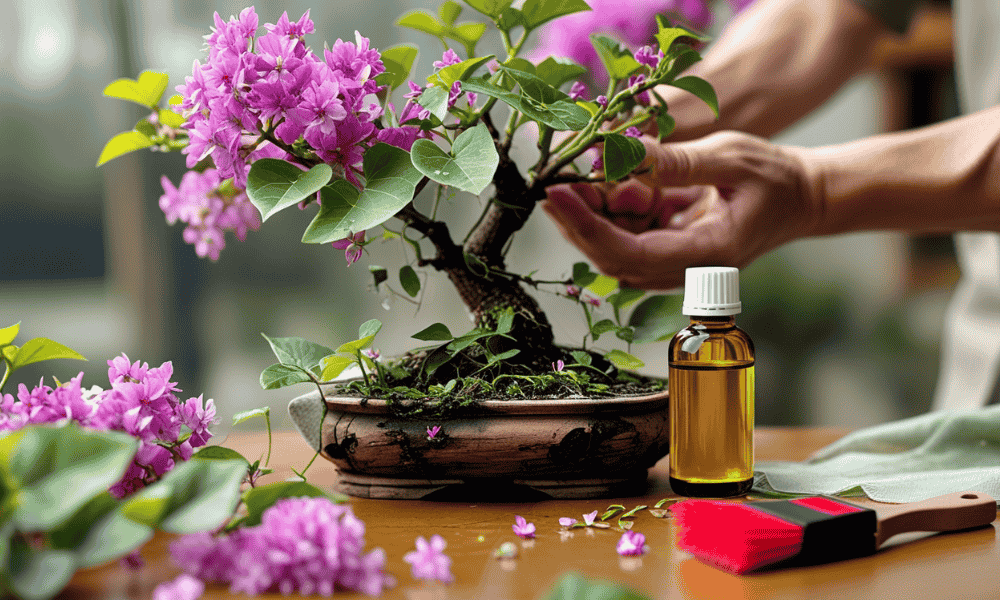
🐛 Pests, Diseases & Troubleshooting
The bougainvillea bonsai plant, despite being tough, can still face issues with pests and other straining environmental factors. Protection of the miniature tree requires prompt diagnosis and treatment.
Common Pests:
- Aphids: Cluster around new growth. Use neem oil or insecticidal soap.
- Mealybugs: Appear as white cottony spots. Remove with alcohol-soaked cotton swabs.
- Spider Mites: Thrive in dry air. Boost humidity and use horticultural oils.
Diseases:
- Root Rot: Caused by overwatering or poor drainage. Prevent by adjusting your watering routine.
- Fungal Leaf Spots: Typically appear in humid conditions. Prune affected leaves and apply a copper-based fungicide.
Troubleshooting Quick Fixes:
|
Problem |
Cause |
Solution |
|
Yellowing Leaves |
Overwatering or nutrient imbalance |
Adjust watering; apply balanced fertilizer |
|
No Flowers |
Lack of sunlight or too much nitrogen |
Move to a sunnier location; switch to high-phosphorus fertilizer |
|
Wilting |
Underwatering or root damage |
Soak the root ball thoroughly; inspect roots |
🌸 How to Encourage Bougainvillea Bonsai to Bloom
One of the most satisfying aspects of bougainvillea bonsai care is seeing the explosion of bright, papery bracts in bloom. However, getting consistent flowering requires a few strategic steps.
5 Proven Techniques to Boost Blooms:
- Maximize Sunlight: Ensure 6–8 hours of full sun daily.
- Limit Watering Before Blooming: Allow slight drought stress (without full dehydration).
- Prune Regularly: Post-bloom pruning stimulates new flowering nodes.
- Use Phosphorus-Rich Fertilizer: Especially during pre-flowering stages.
- Cool Nights, Warm Days: Mimic natural flowering triggers.
📊 Did You Know? In a 2024 horticulture experiment conducted by the Florida Bonsai Society, bougainvilleas with brief water withholding cycles had 22% more blooms than regularly watered plants.
🗓 Seasonal Bougainvillea Bonsai Tree Care Guide
Keeping a bonsai bougainvillea tree thriving throughout the year involves adjusting care routines to seasonal shifts.
🌿 Spring
- Begin fertilizing
- Repot if needed
- Start wiring and structural pruning
☀️ Summer
- Water more frequently (daily if in hot climates)
- Apply high-phosphorus fertilizer
- Prune back after bloom cycles
🍂 Fall
- Reduce watering
- Stop heavy pruning
- Transition outdoor trees indoors if frost is likely
❄️ Winter
- Keep indoors above 60°F (15°C)
- Reduce watering significantly
- Suspend feeding
- Monitor for indoor pests
📌 Climate Tip: In USDA Zones 9–11, bougainvillea bonsai can remain outdoors year-round. In colder zones, treat them as tender perennials and overwinter indoors.
“Bougainvillea bonsai requires a gardener’s intuition. You must know when to cut back—and when to let it thrive wild.”
— Akiko Yamada, Bonsai Artist & Author, The Blooming Bonsai Handbook
During her 2025 lecture for the Bonsai Alliance of America, Akiko stated that “The sun and a bit of stress is how mother nature reveals bougainvillea flowers,” emphasizing the importance of balance during the season.
Moreover, forum sites such as BonsaiNut and r/Bonsai boast of members’ success stories featuring tips on stress cycles and rooting techniques that help maintain vivid flowering through root pruning.
🛍️ Where to Buy Bougainvillea Bonsai Plants
Whether you want to buy your first bougainvillea bonsai tree or want more for your growing collection, you must have a good source. Stressed or poorly raised plants are unlikely to survive repotting or shaping.
Best Places to Purchase:
- Online Nurseries: Trusted sites like Bonsai Boy of New York, Eastern Leaf, or specialized tropical bonsai shops.
- Local Garden Centers: Visit in person to assess the tree’s health and ask about its care history.
- Bonsai Shows & Expos: Ideal for rare cultivars like pixie bougainvillea bonsai, often directly from growers.
What to Look For:
- Healthy foliage (no yellowing or curling)
- Visible root flare but not root-bound
- Strong trunk base with natural taper
- Evidence of proper pruning and branch structure
💡 SEO Tip: IUse phrases such as, “bougainvillea bonsai for sale,” “pixie bougainvillea bonsai near me,” and “cascade bougainvillea bonsai buy online” to draw high intent buyers.
🌳 Popular Bougainvillea Bonsai Styles
1. Cascade Bougainvillea Bonsai (Kengai)
This style, which looks spectacular, depicts a tree growing off a cliff, with its trunk cascading downwards. Bougainvillea trailing vines are perfect for this.
Pro Tip: Use a tall pot and secure the main trunk early with wiring for best results.
2. Pixie Bougainvillea Bonsai
A dwarf cultivar with compact growth. Great for small spaces or indoor bonsai setups. Blooms easily with proper light and is beginner-friendly.
Best For: Apartment dwellers or desk bonsai displays.
3. Informal Upright (Moyogi)
The trunk gently curves while retaining upward motion. Works well with mature bougainvillea trees with thicker trunks.
4. Broom (Hokidachi) and Slanting (Shakan) Styles
These styles highlight the tree’s dynamic movement. Bougainvillea responds well to dramatic shaping when young.
✅ Bougainvillea Bonsai Care Checklist
Here’s a simple, printable bonsai care checklist:
|
Task |
Frequency |
|
Watering |
Every 2–3 days in warm weather, less in winter |
|
Sunlight |
6–8 hours daily |
|
Pruning |
After each bloom cycle |
|
Fertilizing |
Bi-weekly during the growing season |
|
Repotting |
Every 2–3 years |
|
Pest Check |
Weekly |
|
Bloom Boost |
Light drought stress before flowering |
Use this schedule to keep your bonsai bougainvillea tree in peak condition all year long.
🎯 Conclusion: Why Bougainvillea Bonsai Belongs in Your Collection
Your collection cannot be truly complete without a bougainvillea bonsai because it is not just a plant, but a living sculpture that displays your care, creativity, and bond with nature. This bonsai adds an extra touch to any area due to its flowers and tropical feel.
Now is the perfect time to start if you’re intrigued by the cascades of bougainvillea bonsai or enchanted by its pixie varieties. Just ensure you follow the right bougainvillea bonsai care instructions, and you’ll find yourself with a miniature masterpiece that truly blooms.
🌟 Embrace the joy of bonsai. Start your bougainvillea bonsai journey today!
🔍 Bougainvillea Bonsai FAQs (2025 Optimized)
How often should I water my bougainvillea bonsai?
Use the dry-and-soak method: water deeply only when the top inch of soil is dry. Avoid keeping the soil consistently moist.
Can I grow bougainvillea bonsai indoors?
Yes, but they need direct sunlight for a minimum of 6 hours a day. Use grow lights to make up for the lack of natural light.
How can I get my bougainvillea bonsai to bloom?
Reduce watering slightly before bloom season, apply a high-phosphorus fertilizer, and ensure the plant gets enough sunlight. Prune after blooming to stimulate flower production.
What is the best style for beginners?
Beginners will do best with the bougainvillea pixie bonsai styles or informal upright styles due to their ease of growth and training.
How do I prevent pests?
Check leaves once a week. Treat aphids, mealybugs, and spider mites with neem oil or insecticidal soap when first spotted. Maintaining proper airflow helps prevent infestations.
How to take care of a bougainvillea bonsai?
To care for a bougainvillea bonsai tree, provide 6–8 hours of direct sunlight daily, use well-draining bonsai soil, water only when the soil is dry, prune regularly after blooming, and fertilize with a phosphorus-rich formula every two weeks during the growing season.

